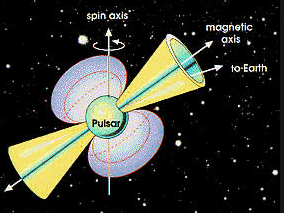
The Difference between Pulsar and Quasar is given here. A pulsar is a neutron star with a strong magnetic field that emits periodic electromagnetic radiation. A quasar or quasar is a source of electromagnetic energy that includes radio frequency and visible light. keep reading…
Pulsar
Pulsar is the acronym in English for pulsating star, which means “star that emits very intense radiation at short and regular intervals.” It is a neutron star that emits periodic radiation. Pulsars have an intense magnetic field that induces the emission of pulses of electromagnetic radiation at regular intervals related to the rotation of the object.
Neutron stars can rotate on their axis up to several hundred times per second. A point on its surface moves at speeds of up to 70,000 km / s. this means that neutron stars rotate so fast that they expand their equator. It also implies that its stars are between 10 and 20 kilometers in size. The centrifugal force generated at this speed is enormous and only their powerful gravitational field prevents them from being destroyed. Pulsars are composed of an iron core that, when rotating at high speed, emits its own magnetic field, which is not centered on its rotating poles.
Quasar
It is an astronomical source of electromagnetic energy, it includes radio frequencies and visible light. They are phenomena that arise when a large black hole located in the nucleus of a galaxy absorbs all the matter that is in its vicinity. When this happens, due to the enormous speed of rotation, a large amount of energy is produced that is released in the form of radio waves, light, infrared, ultraviolet, and X-rays. This makes quasars the brightest objects in the world. universe. In telescopes, they appear as simple points of light, although some appear to be the center of active galaxies. suggested video: Pulsar vs Quasar
Difference between Pulsar and Quasar
- Pulsars are neutron stars that periodically emit radiation. They are composed of three layers: a solid core, a “liquid” mantle, and a thin, solid crust.
- Pulsars spin at high speed and emit regular pulses of electromagnetic radiation.
- Pulsars are the product of the explosive transformation of a massive star.
- Quasars are similar to stars, but they are not. They are extremely luminous objects at all wavelengths.
- They are believed to form from black holes when a large part of their mass is converted into energy. This energy is what we can see as a quasar.
- Quasars can release energy capable of illuminating a galaxy with the equivalent of millions of suns.
- Quasars are larger than pulsars.
- Pulsars are less bright than quasars.
- Pulsars rotate.
- Quasars do not rotate.